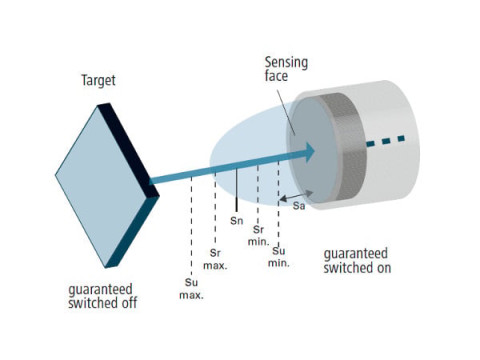Inductive sensors are electronic devices that utilize changing magnetic fields to detect metallic or ferromagnetic materials, converting that information into an electrical signal. This principle enables a wide range of applications—from position detection and speed measurement to process monitoring in industrial automation. Below, we explore how inductive sensors work, their common types, practical uses, and leading brands in the global market.
1. How Inductive Sensors Work
1.1 Core Design and Construction
Most inductive sensors are built within a sealed metal or plastic housing filled with a protective compound (e.g., epoxy). Internally, they generally include:
- Electromagnetic Field Generator: A high-frequency oscillator and coil (often with a ferrite core) produce a localized magnetic field in front of the sensor face.
- Detector or Trigger Stage: Monitors changes in the oscillator’s amplitude when a conductive object enters the magnetic field, altering the sensor’s inductance.
- Amplifier and Switching Stage: Converts the detected signal change into a usable electronic output, either a switching signal (on/off) or an analog measurement.
- Status Indicator (LED): Shows operational or switching states.
Because they are fully enclosed with no moving parts, inductive sensors can operate in harsh environments—offering reliability, minimal maintenance, and long service life.
1.2 Key Specifications
- Operating Voltage (DC or AC): Commonly 12–24 VDC or up to 220 VAC for specific models.
- Maximum Switching Current: Defines load capacity or the external relay/driver needed.
- Switching Frequency: Can reach 1–5 kHz or more, supporting rapid on/off cycles.
- Sensing Distance: Usually a few millimeters up to a couple of centimeters, depending on sensor design and target metal type.
- Environmental Ratings: Many variants handle temperatures from –40°C to +60°C and beyond, with IP ratings to ensure water and dust protection.
2. Types of Inductive Sensors
2.1 Basic Proximity Switches
Often called proximity sensors, these detect a metal object entering or leaving a specific “sensing zone.” They commonly switch an internal transistor or relay output, enabling direct use as an on/off input in automation or safety systems.
2.2 Differential Sensors
Some advanced designs use dual sensing coils or more complex internal configurations to improve accuracy and rejection of interference, especially in higher-precision tasks. The differential approach can offer better sensitivity and stability.
2.3 Transformer-Based (LVDT-Style) Sensors
Linear Variable Differential Transformers (LVDTs) measure slight displacements. They generate a secondary coil voltage varying with the position of a movable core. This principle sees application in measuring angles, small linear motions, or position feedback in servo controls.
3. Applications and Use Cases
3.1 Industrial and Mechanical Processes
Inductive sensors have largely replaced mechanical limit switches in many factory settings:
- End-of-Travel Detection: Checking door or gate positions, ensuring safety interlocks.
- Object Presence Monitoring: Verifying parts on conveyor belts, counting items, or preventing collisions.
- Machine Safety Lockouts: Immediately halting equipment when guards or covers are opened.
3.2 Position and Movement Feedback
In more refined systems, differential inductive or LVDT-type sensors measure:
- Precision Displacement: From micrometer-level movements up to centimeter-scale.
- Angle or Rotation: By monitoring a rotating ferromagnetic disc or gear and detecting changes in inductance.
- Pressure Transducers: Some designs incorporate a moving core linked to diaphragms or pistons, converting fluid/gas pressure into an inductive reading.
3.3 Speed and Frequency Sensing
By counting the frequency of pulses when gear teeth or other metal features pass near the sensor coil, an inductive speed sensor can measure:
- Rotational Velocity: e.g., in motors, turbines, or automotive crankshafts.
- Direction and Phase: Combining signals from multiple sensors or special gear patterns can indicate the sense of rotation.
4. Leading Global Brands
4.1 IFM Electronic
A German-based corporation that offers a comprehensive range of sensors for automation, including inductive proximity switches and advanced measurement solutions. Known for high quality and reliability.
4.2 Balluff
A global leader in industrial sensing technology. Balluff’s inductive sensors span a broad array of sizes, materials, and output configurations, with emphasis on durable build and consistent performance.
4.3 Turck
Turck specializes in a variety of automation components, from proximity sensors to fieldbus solutions. Its inductive sensors feature robust housings, flexible connectivity, and diverse form factors.
4.4 AECO
An Italian manufacturer focusing on sensors, switches, and control devices. AECO is recognized for versatile product lines covering different sensing principles, including inductive.
4.5 Chinese Brands
Many manufacturers in China produce budget-friendly inductive sensors. While offerings vary in quality, they can be economically viable for basic applications. Always confirm compliance with relevant standards and specifications before integration.
5. Practical Considerations
- Power Quality: Inductive sensors often require stable DC supplies; heavy transients or noise can disrupt readings or damage circuitry.
- External Magnetic Fields: High-voltage lines or large motors may distort the sensor’s output. Shielding or careful placement helps maintain accuracy.
- Mounting Distances: Non-flush vs. flush-mounted sensors differ in how close metallic surroundings can be without affecting detection range.
- Environmental Conditions: For high-heat or extreme cold, check for sensors rated accordingly. Some versions withstand temperatures well below –40°C or above +200°C.
Conclusion
Inductive sensors harness electromagnetic principles to detect metal objects or measure physical parameters like position, displacement, pressure, or speed. Their sealed, contact-free design ensures durability and longevity across industrial, mechanical, automotive, and safety applications.
As a versatile and dependable technology, inductive sensors continue to replace mechanical switches in countless scenarios. When choosing an inductive sensor, consider parameters like sensing distance, switching frequency, power requirements, and environmental ratings. With a wide range of offerings from international brands, integrators can find the ideal sensor for nearly any automation or measurement challenge.
To learn more about selecting and deploying inductive sensors for your specific needs, reach out to safsale.com—we provide expert guidance, product insights, and solutions for achieving reliable, high-performance sensing in modern automated systems.

